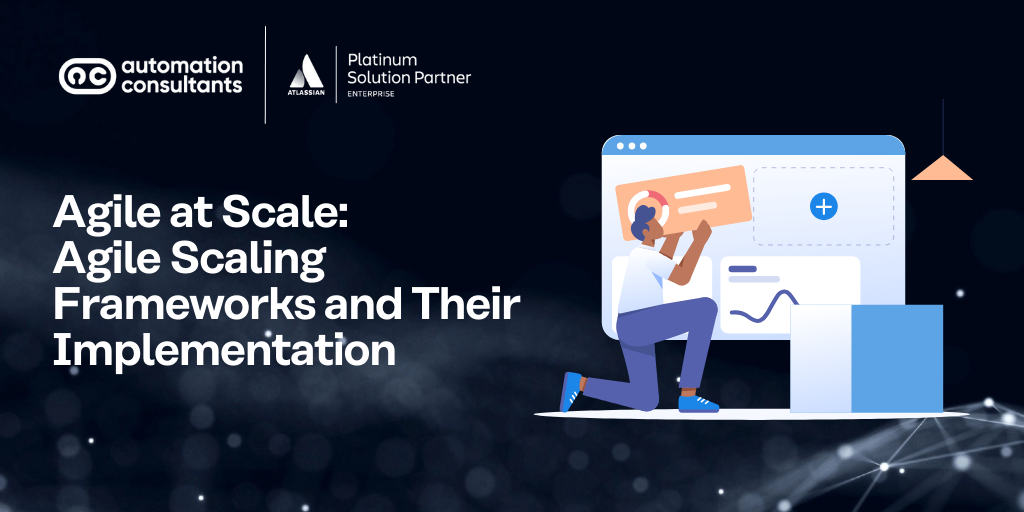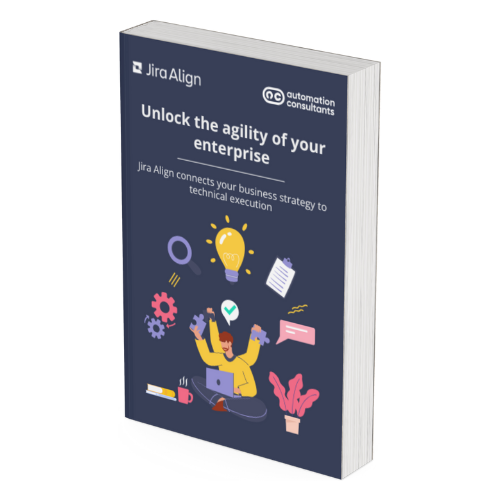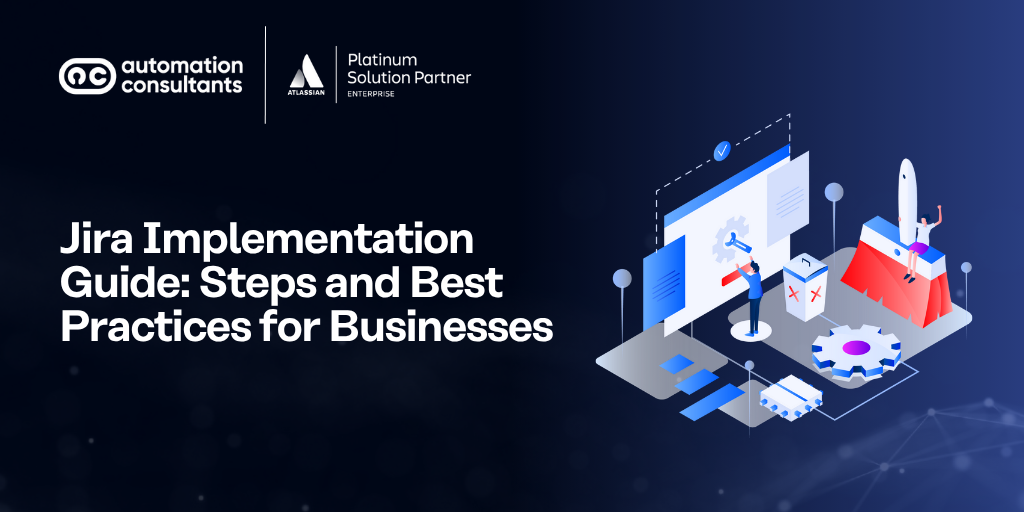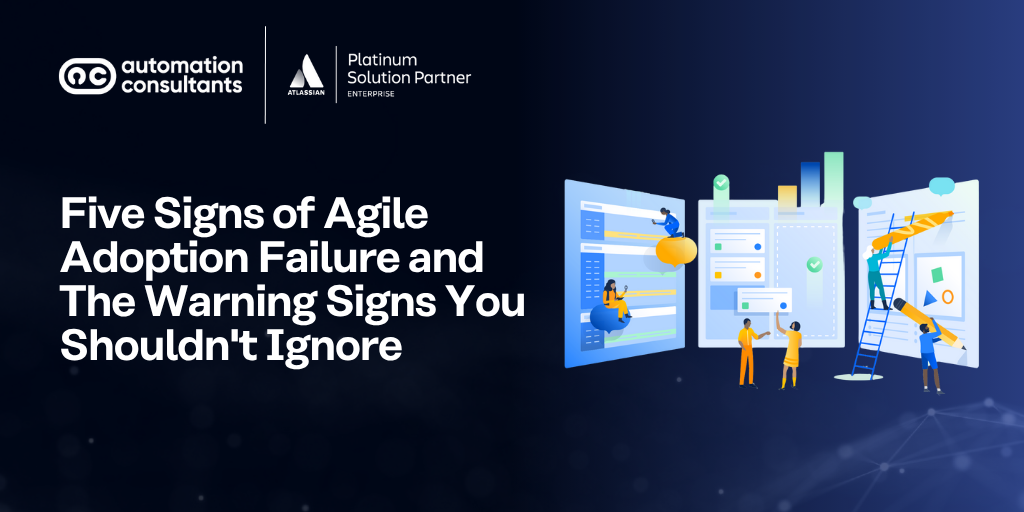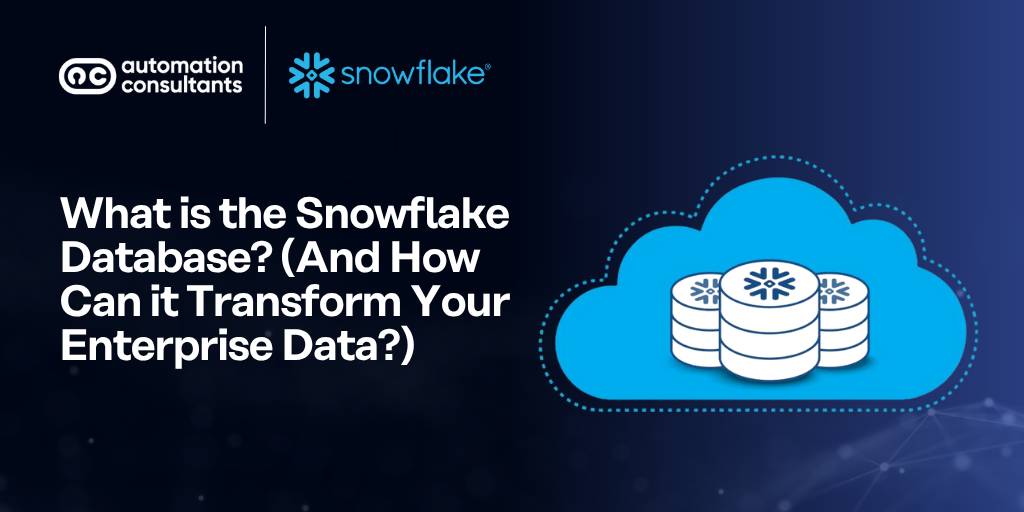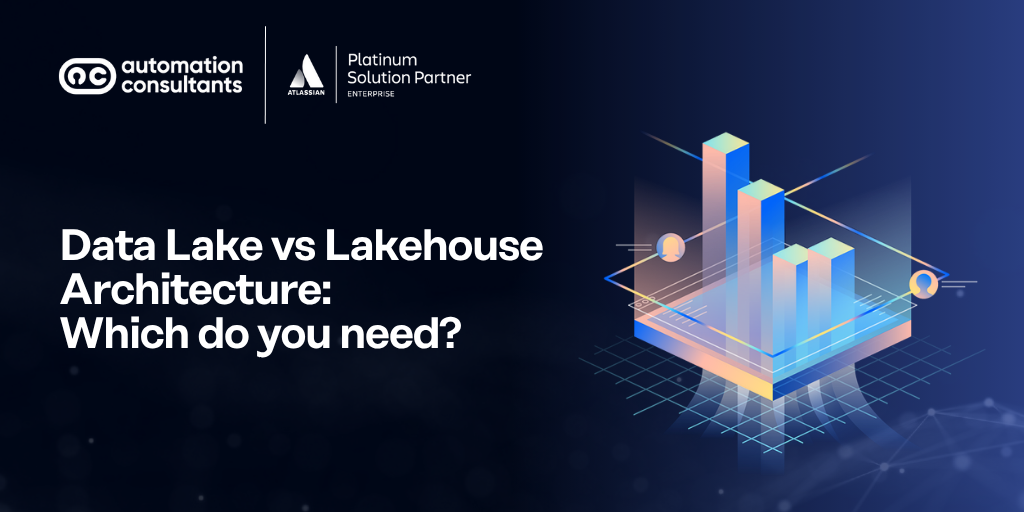Welcome to the first of our series on Agile at Scale. If you’re a large organisation looking to achieve enterprise-level agility, you’re come to the right place.
In this post, we’re going to:
- Guide you through the core principles of scaled Agile
- Explore both the challenges and benefits that enterprises may experience on their Agile journey
- Touch on Agile Scaling frameworks and implementation
But before we delve in further, let’s begin with a definition of Agile and Agile at Scale.
What is scaled Agile?
To understand scaled Agile, it’s essential to understand what Agile is first.
What is Agile?
Agile is a mindset that promotes developing functional products and delivering solutions in very short, iterative bursts through collaboration and flexibility. The work required for a project is normally broken down into small, achievable parts, with a focus on continuous improvement and feedback.
Using Agile frameworks
Now, to work in an Agile way, most teams will use a framework to guide their processes, roles and timescales. In Scrum, for example, one of the most popular frameworks, each of these small parts of work is referred to as a ’user story’ and is completed in a sprint, which usually lasts for about one to four weeks.
At the end of the sprint, the client gets a functioning piece of software or a deliverable. Feedback is then incorporated into the next sprint to maintain continuous innovation and improvement.
Why is Agile so popular?
Agile software development has become highly popular, as it simplifies and streamlines project management.
It places a real emphasis on continuous improvement, maximising value, and establishing a culture where mistakes are recognised as learning opportunities. All of this contributes to an organisational environment that fosters trust, ingenuity and collaboration.
The good news is that, with the right framework, smaller teams can adopt new Agile methodologies almost effortlessly.
Unfortunately, however, achieving business agility at scale isn’t as easy for larger enterprises or more complex projects. This can be due to a number of factors: Multiple teams, overlapping projects, cross-functional dependencies… With all of these at play, enterprises need a more coordinated approach to Agile.
This is where scaled Agile comes in.
So, what is Agile at Scale?
Scaled Agile is a system for applying Agile values and principles across a larger organisation.
As with Agile itself, there are a number of Scaled Agile frameworks to provide the structure, roles and processes enterprises may need on their journey.
We’ll explore these in more depth further on in this post.
What does an Agile enterprise look like?
At a minimum, all of an organisation’s software and IT teams would have adopted Agile ways of working. Their working practices would be similar enough across the organisation for them to work cohesively towards common goals.
Dependencies between teams would be communicated and handled more smoothly. Mature Agile processes would also enable more accurate predictions about delivery timescales, enhancing budgeting and release planning.
As these habits spread across teams and departments, most organisations find they develop Agile characteristics themselves. Ultimately, this results in a more nimble and responsive enterprise.
Why become an Agile enterprise?
For large organisations trying to achieve agility, there are many challenges along the way—and we’ll go into these shortly. But if you can overcome these, Agile transformation can deliver significant benefits that are worth the effort.
Essentially, Agile a Scale brings the benefits of team-level Agile practices to your entire organisation.
Benefits of Agile at the enterprise level
- Your organisation can deliver constant value at higher quality and lower cost than we see with more traditional ways of working (such as Waterfall-style software development or project management)
- You react faster to changes in the market and stay one step ahead of the competition
- Greater predictability and adherence to budgets keep your stakeholders happy
- There is improved visibility and trust across management and teams at ground-level
- Agile encourages a culture of learning and embracing failure
- Sustainable, worthwhile processes and tools help protect your organisation’s sizeable investments in software
- Dependencies between teams are communicated and handled effectively
- You can predict delivery timescales more accurately, strengthening your budgeting and release planning
- Your organisation is in a stronger position to embrace novel technologies and revolutionary solutions
- You’re better poised to change course in time to meet shifts in customer demand or competitive threats
Is Agile scaling easy to implement in big corporations?
In a word, no. As you know, we’re real advocates for embedding Agile at an enterprise level, and believe the long-term benefits ultimately outweigh the hurdles you may face during your journey.
But there are, as you’d expect, quite a few obstacles.
Core challenges
- Getting a large number of people to adopt a common system of working
- Changing teams and individuals’ deeply ingrained habits
- Overcoming silos and its fiefdoms, which are common in large enterprises
- Resistance to change
- Some teams may feel their function requires a different approach from that adopted elsewhere in the organisation
- Securing top-level buy-in
- Not having the right tooling
- Not having the right framework
Now, we know from experience that breaking down these barriers is not easy. To do so, team members must believe that the effort is worthwhile and will deliver tangible benefits to their working environment, job satisfaction and output.
Buy-in like this cannot be imposed quickly from the top (although senior management commitment is essential) but instead must be embedded effectively, with clear communication and ongoing support.
This is where turning to dedicated Agile consultants or an Agile coach can prove invaluable. With skill and experience, these practitioners can guide you through the process of selecting and embedding your Scaled Agile framework.
Discover more about business agility
Download our free Jira Align overview cheat-sheet to find out more about how Jira Align connects your business strategy to technical execution.Where should an organisation start with an Agile transformation?
The Agile manifesto was published in 2001.
Fast-forward to today, and most organisations have at least a few teams already using Agile methods in their daily operations – particularly in their IT software development teams. This is a good start, but there’s a long way to go until we see fully Agile enterprises.
Start with software development
Usually, large organisations begin their Scaled Agile journey by rolling out Agile working across all their enterprise-level development and IT projects. Your organisation then may work towards the ultimate goal: ‘enterprise agility’, where these benefits extend beyond software development and IT into the wider enterprise.
Before an organisation’s Agile framework can be adopted (or even chosen), it’s important to understand how those teams work. Where is there common ground, and where are the greatest disparities? What is working well, and what are the major pain points? If you’re going to change the daily lives of hundreds of developers, you’ll need to understand the impact it’ll have.
Additionally, it’s crucial to grasp the overarching objectives of your framework. What organisational challenges are you aiming to address? Pinpoint areas that require improvement. Engage with key stakeholders, including finance teams, human resources, and even customers.
Build up a list of your requirements and the appetite for change at all levels of the organisation. Determine the extent of buy-in you can expect and the resources you might have at your disposal. Finally, see if you can start getting people on board as you go, fostering a sense of shared anticipation and positivity about the potential changes that Agile can bring.
So, what now?
Once you know where you’re starting from and understand where you’re trying to go, it’s time to choose a framework. For many organisations, the framework they choose is less significant than the decision to embed enterprise Agility in the first place.
This is in keeping with the Agile maxim of valuing individuals and interactions over processes and tools.
The various scaling frameworks have material differences. In the next article in this series, we will examine some of the leading ones and compare their main strengths and weaknesses.
However, here’s a quick introduction:
Popular frameworks for scaling Agile
Most organisations that have successfully embraced enterprise agility have adopted a framework like Scaled Agile Framework (SAFe), Scrum at Scale (S@S), Large Scale Scrum (LeSS), Disciplined Agile (DA), Nexus, or Spotify.
These frameworks coordinate the work of many Agile teams, providing formal structures for them to communicate with each other.
Scaled Agile Framework®
SAFe® is currently one of the most popular frameworks for enterprises. It provides guidance on the best ways to plan and manage work and on the roles and responsibilities of individuals.
The framework is structured around three primary levels: Essential (covering Team and Program), Large Solution, and Portfolio. Each level addresses specific aspects of the organisational structure:
Essential Level
This level is divided into two layers: Team and Program. At this level, teams work in sync using these practices, typically employing Scrum or Kanban to deliver value in fixed-length iterations. Multiple Agile teams are coordinated to work on larger projects through the Agile Release Train (ART), which aligns teams to a common mission using synchronised iterations.
The Essential level has ten components:
- Lean-Agile principle
- ART
- Rhythm and synchronisation
- Product increment (PI) planning
- DevOps and releasability
- System-level demo
- Inspection and adapting
- Planning iteration and innovation
- Architectural runway
- Leadership
Large Solution Level
This level addresses the additional complexities and dependencies for enterprises building large and complex solutions that require coordination. It uses several ARTs that work together, and has four additional components:
- Train in a way that coordinates and communicates with multiple trains.
- Intent to build a quality system
- Context description for how the system will interface
- Kanban to manage the capability flow
Agile Portfolio Level
This highest level focuses on enterprise strategic themes and guides investment in solutions that provide the most business benefit. This level prioritises:
- Lean budget
- Authority to make decisions
- Funding people and resources for value delivery
- Portfolio Kanban for work visibility
- Portfolio canvas to outline the objectives of the portfolio Kanban
Large Scale Scrum
Scrum is one of the more popular Agile approaches today. A Scrum team consists of product owners, scrum masters, and developers. They work in sprints, daily standups and a retrospective at the end of each sprint.
LeSS is one of the frameworks that helps businesses expand Scrum in an enterprise. Its core principles are:
Large Scale Scrum Is Scrum
LeSS does not introduce a radically different approach or change the basic principles of Scrum. It stays true to the same Scrum Guide and practices, such as sprint planning, daily Scrum, sprint review, and sprint retrospective.
Simplicity and Minimalism
Like Scrum, LeSS focuses on simplicity. It seeks to remove unnecessary complexity and processes. The idea is to ramp up Scrum in a way that keeps additional roles, artefacts, and processes to a minimum.
Whole-Product Focus
LeSS encourages teams to see the product as a whole rather than working on separate parts in isolation. This holistic approach helps ensure that the product develops cohesively while maintaining a high level of quality and consistency across various teams.
Feature Teams
Scrum emphasises versatility within a single team. To that end, LeSS promotes the use of cross-functional, feature-based teams rather than component-based specialised teams. Each team is capable of independently delivering significant chunks of the product.
Transparency and Communication
Central to both Scrum and LeSS is the importance of transparency and clear communication. In LeSS, this is enabled through practices like the overall retrospective and the overall product backlog refinement, where representatives from various teams come together to discuss progress and challenges.
Continuous Improvement
Just as Scrum teams continuously reflect and adapt their processes within each Sprint, LeSS teams do the same, but more extensively. This continuous improvement helps address the complexities and coordination challenges that arise in large-scale development.
Disciplined Agile
Where SAFe and LeSS are structured, DA (previously called DAD for Disciplined Agile Delivery) is much more flexible. It combines the strongest elements from different frameworks, including Scrum and Kanban. Since it offers guidance rather than rules, you can adapt it to the requirements of your departments while still following the Agile principles.
Unfortunately, its biggest advantage is also its greatest drawback. Its flexibility makes it rather difficult to use for businesses that are new to Agile. However, this might be the right framework for you if you’re already using Agile project management.
The four foundational views of DA are:
Mindset
The DA encourages organisations to follow the Agile mindset, which means aligning with its eight principles that encourage adaptability and effectiveness, the seven promises it asks organisations to make to themselves and their people, and the eight guidelines that enable the fulfilment of those promises.
People
This toolkit allows people to take on one or more roles within the organisation. It encourages the way of working (WOW) that fits with your organisation instead of trying to create exact matches against a template.
Flow
DA provides a streamlined process flow within your organisation’s context. It allows you to understand the separate activities that must come together at the right time in the right manner to create a smoother workflow.
Practices
The DA toolkit provides two separate strategies for scaling Agile at the team and organisation levels: tactical Agile and strategic Agile. The guidelines allow you to easily apply agility to different aspects of your business.
Along with the four views, DA also has four process levels built into it:
- Foundation
- Disciplined DevOps
- Value streams
- Agile enterprise
Scrum@Scale
Like LeSS, the S@S framework facilitates Scrum implementation. This system combines the principles of Scrum and complex adaptive systems theory to offer a modular and flexible implementation system. It’s especially good for implementing Scrum within all departments of an enterprise, be it HR or marketing.
S@S is easily scalable, with components like scaled roles, events, and enterprise leadership. It includes regular synchronisation meetings, such as the “Scrum of Scrums,” which is a key meeting point for Scrum Masters from different teams to discuss progress, issues, and coordination.
Because of its focus on productivity and efficiency, it helps your business reduce organisational waste and improve communications.
Spotify Model
The Spotify model is named after the music streaming service as it’s how the company scaled Agile within the organisation. Spotify published its workflow patterns for implementing Agile in 2012. The key elements of this method are:
Squads
Much like Scrum teams, squads are autonomous teams that work on one feature area, with an Agile coach and the owner. They have their own mission, which they use to determine which methodology or framework they’ll follow.
Tribes
When multiple squads coordinate with each other to work on a feature area, they are called a tribe. This group of 40–150 members is led by a tribe lead.
Chapters
Whilst squads are autonomous, the different specialists in them have to adhere to certain standards. A chapter is a family of specialists, led by a senior technology lead.
Guilds
Team members can form a guild if they are interested in a topic. Unlike chapters, which are contained within tribes, guilds can be across different tribes.
Trio
The tribe lead, product lead, and design lead form the trio that keeps a tribe aligned in these three departments.
Alliance
When multiple tribes have to work together, they form an alliance. It’s normally a combination of the tribe trio that keeps them collaborating towards the common goal.
Nexus
Nexus brings together multiple Scrum teams — usually three to nine — under a single product owner. The product owner manages a single product backlog for the entire Nexus, ensuring that backlogs are de-conflicted and prioritised across teams.
Each team follows standard Scrum roles, events, and artefacts.
The team roles include the Product Director, a Scrum Master, and one or more Nexus integration team members who might also be part of the individual Scrum teams. This team is responsible for overseeing the integration and smooth functioning of the product increment.
Events include:
- Sprint planning
- Daily Scrum
- Refinement
- Sprint review
- Sprint Retrospective
Artefacts include integrated increments, where the combined work of the various teams is integrated and tested as a whole, and sprint backlogs, which contain the team’s work along with the dependencies across team backlogs.
Considering implementing Agile at Scale practices within your organisation?
For any large organisation, if Agile is worth applying at the team level, it’s worth implementing at the organisation level. Enterprise-level agility ensures that the business operates as effectively as possible and guarantees an advantage over competitors who may remain in the old world of Waterfall development and linear project management. The transition might be long and hard, but you don’t have to take it on alone.
Automation Consultants are experts in implementing Agile practices and would love to join you on your journey. If you’re not sure where to start, why not get in touch? We’d be happy to lend a hand.
As an Atlassian Enterprise Platinum Solution Partner, an official Scaled Agile partner, and with a team of Jira Align certified consultants, your Agile at Scale transformation is in safe hands. We provide a wide range of services, from Atlassian Jira Align implementation, best practice advice and support, to bespoke training programmes tailored to your business.

